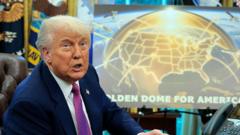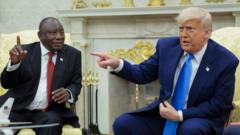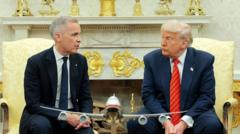**The 'Golden Dome' concept reveals complexities and costs that could reshape America's defense landscape.**
**Trump's Ambitious Plans for the 'Golden Dome': A Defense System for the Future**

**Trump's Ambitious Plans for the 'Golden Dome': A Defense System for the Future**
**The proposed missile defense initiative aims to bolster US security against high-tech threats.**
In a bold attempt to fortify the United States against emerging global threats, President Donald Trump has unveiled ambitions for a revolutionary missile defense system dubbed the 'Golden Dome'. This proposed initiative seeks to protect the nation against advanced weaponry, including hypersonic missiles and orbital bombardment systems introduced by rival powers like Russia and China.
Experts warn that the current defense infrastructure is inadequate to combat such threats, especially considering that a single nuclear detonation hundreds of miles above the U.S. could unleash catastrophic electromagnetic pulses, devastating critical infrastructure and daily life. In light of these concerns, Trump aims for a "next-generation" missile shield that combines land, sea, and space technologies, enhancing capabilities to detect and intercept a broader range of threats.
Defense officials have remained vague about the specifics of the Golden Dome, which is still conceptual. However, they envision a multi-layered system structured across various platforms, indicating a shift in U.S. missile defense strategy. Current capabilities focus primarily on static intercontinental ballistic missiles (ICBMs) but need to expand to counter new space-based weapon threats.
While many support the initiative, they caution against the exorbitant costs and logistical hurdles associated with integrating such advanced systems. Trump's estimated expenditure of $175 billion significantly underestimates the Congressional Budget Office's projection of $542 billion over two decades, primarily for space-based components alone. Despite the financial burden, advocates believe that a partially built Golden Dome could significantly deter aggression and protect the homeland, potentially avoiding catastrophic scenarios.
As national defense strategies evolve in response to high-tech threats, the Golden Dome represents a major pivot in U.S. defense policy, aiming to strengthen deterrence while possibly inciting an arms race among global adversaries. Ultimately, its development may redefine how the U.S. navigates the complexities of modern warfare and international security.
Experts warn that the current defense infrastructure is inadequate to combat such threats, especially considering that a single nuclear detonation hundreds of miles above the U.S. could unleash catastrophic electromagnetic pulses, devastating critical infrastructure and daily life. In light of these concerns, Trump aims for a "next-generation" missile shield that combines land, sea, and space technologies, enhancing capabilities to detect and intercept a broader range of threats.
Defense officials have remained vague about the specifics of the Golden Dome, which is still conceptual. However, they envision a multi-layered system structured across various platforms, indicating a shift in U.S. missile defense strategy. Current capabilities focus primarily on static intercontinental ballistic missiles (ICBMs) but need to expand to counter new space-based weapon threats.
While many support the initiative, they caution against the exorbitant costs and logistical hurdles associated with integrating such advanced systems. Trump's estimated expenditure of $175 billion significantly underestimates the Congressional Budget Office's projection of $542 billion over two decades, primarily for space-based components alone. Despite the financial burden, advocates believe that a partially built Golden Dome could significantly deter aggression and protect the homeland, potentially avoiding catastrophic scenarios.
As national defense strategies evolve in response to high-tech threats, the Golden Dome represents a major pivot in U.S. defense policy, aiming to strengthen deterrence while possibly inciting an arms race among global adversaries. Ultimately, its development may redefine how the U.S. navigates the complexities of modern warfare and international security.























